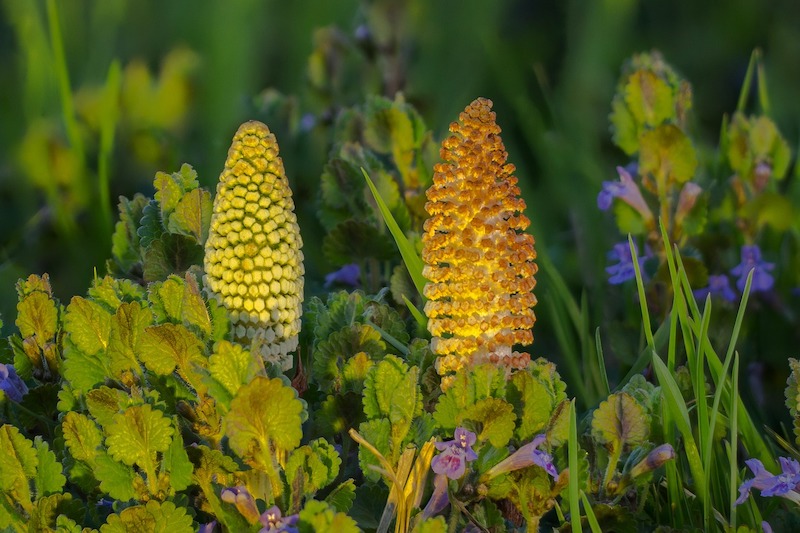Cattails are a lovely addition to any pond, but they can be slightly invasive and difficult to restrain. Read on to find out how to maintain cattail ponds and control mulberry tree roots.
Cattails and Mulberries
Q: I have a question about vegetation in ponds. I live in a golfing community that has several ponds in which I fish daily for bass. The largest of these ponds has cattails growing at an alarming rate, about 3 feet per month along the edge. Will these annoying cattails eventually consume the whole pond and take oxygen out of the water, thus killing all the fish? I realize that they do make good cover for the fish, but enough is enough! How do you control their growth?
A: Cattails that are growing that fast are getting fed pretty heavily. It could be too much lawn fertilizer runoff, or it could be septic or other pollution coming in with the water. Either way, the cattails are doing a very good job removing the pollution that would otherwise feed other plants, meaning mostly algae. If the ponds are connected, the cattails are helping keep other ponds clean, too.
Other prettier plants could be planted to replace the cattails, but they may not grow as rapidly. As cattail leaf matter dies and falls into the pond, it becomes a layer of organic matter into which the roots will grow. Eventually, the excess feeding of the cattails will allow the cattails to fill the pond, and it will become a marsh. But the cattails will not take oxygen from the water or kill the fish.
Killing a bunch of the cattails and leaving the organic matter in the pond to decay will allow an explosion in the bacteria population, which will take out the oxygen as it consumes the dead organic matter. So killing cattails includes removing the dead material.
If the ponds are in a northern climate that will freeze over for several weeks in the winter, the cattails will be easy to kill. The roots get their oxygen from the hollow stems. Cut off the stems below water level, and remove all the stems and leaves. When the ice caps the pond, the remaining roots will drown. If possible, drain the pond water level to do the cutting, and then fill the pond back up so the ice forms high over the roots. If that can't be done, there are several chemical controls for cattails that a professional pesticide applicator could apply.
Q: Do I need to cut down a mulberry tree? I don't want to, because it shades the patio during the summer, but I was told that this tree will cause problems for my septic system. My septic tank is about 10 feet from the tree trunk, and the lateral pipes are within 20 feet. This tree is big and well-established. Also, is there any way to stop the tree from producing fruit? The ocean of purple fruit can be quite squishy and messy.
A: Large tree roots grow in all directions, and small roots grow in all directions off of each main root. If a root finds dry soil, it won't survive. If it finds moist soil, it will grow better and send out more small roots. Tree roots cannot search for and find water, especially water inside a pipe. They merely grow faster and bigger in response to finding water. Most dry-land plant roots need air in the soil, too, so too much water all the time will drown them.
Just because there are trees near a septic system does not mean that you will have problems. Septic system pipes are designed to leak nutrient-rich water. As the pipe drains, air is let back into the pipe. So a tree root that finds septic system water is likely to grow very well. It is not a guarantee that the root will grow into the pipe's holes or cracks and clog it up. A pipe that is wrapped in weed barrier cloth will prevent roots from growing into it for a long time. Roots growing outside the pipe will pull water away from the pipe and surrounding soil, so the soil will not become full of water as fast, and the system can be used more often.
Tree roots grow three to four times the length of tree branches. Looking at it this way, how many trees are within reach of your septic system? Tree roots grow under and past driveways and sidewalks, so if necessary, count your neighbor's trees, too. Once there are tree roots giving you problems, you will need to determine which tree they came from because the closest tree may not be the culprit.
Mulberry trees do not live the longest and are pretty low on most lists of desirable trees. As you know, they can be very messy. To some, the fruit tastes as good as blackberries. If the tree were out in the back forty somewhere, it would be worth keeping, if only for the birds. But it may not be worth keeping up near the house. You may want to plant a new tree farther from the septic system for future shade, so the mulberry can be replaced in a few years. I don't have any help to offer for preventing it from producing fruit.
Save or share this infographic for reference: Cattails and Mulberries

Email questions to Jeff Rugg at [email protected]. To find out more about Jeff Rugg and read features by other Creators Syndicate writers and cartoonists, visit the Creators Syndicate website at www.creators.com.
COPYRIGHT 2017 JEFF RUGG
DISTRIBUTED BY CREATORS.COM



